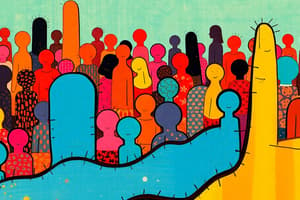Podcast
Questions and Answers
What was one consequence of not following the population control policy in China?
What was one consequence of not following the population control policy in China?
- Fines and loss of educational rights (correct)
- Employment bonuses
- Increased health insurance benefits
- Promotion of large families
The total fertility rate in China has increased since the implementation of the population control policy.
The total fertility rate in China has increased since the implementation of the population control policy.
False (B)
What is one of the criticisms faced by the Chinese population control policy?
What is one of the criticisms faced by the Chinese population control policy?
Human rights abuses.
The population growth rate in China has fallen to about _____ today.
The population growth rate in China has fallen to about _____ today.
What was one success of the population control policy in China?
What was one success of the population control policy in China?
Match the following terms related to migration with their definitions:
Match the following terms related to migration with their definitions:
Female infanticide has not been an issue in the context of China's population control policy.
Female infanticide has not been an issue in the context of China's population control policy.
The so-called 'little emperors' syndrome refers to the spoiling of _____ children in a family.
The so-called 'little emperors' syndrome refers to the spoiling of _____ children in a family.
Which of the following factors has contributed to declining fertility rates?
Which of the following factors has contributed to declining fertility rates?
Women generally have a lower life expectancy than men.
Women generally have a lower life expectancy than men.
What is the definition of infant mortality?
What is the definition of infant mortality?
The highest life expectancy in the world is found in __________.
The highest life expectancy in the world is found in __________.
Match the following terms with their definitions:
Match the following terms with their definitions:
Which factor does NOT contribute to the declining need for larger families?
Which factor does NOT contribute to the declining need for larger families?
Delayed marriage is a factor that contributes to increasing family size.
Delayed marriage is a factor that contributes to increasing family size.
What is a major reason women in many countries live longer than men?
What is a major reason women in many countries live longer than men?
Which of the following is considered a cause of forced migration?
Which of the following is considered a cause of forced migration?
Natural disasters are a cause of voluntary migration.
Natural disasters are a cause of voluntary migration.
Name one advantage of migration for the host country.
Name one advantage of migration for the host country.
Migrants may return home with new _____ learned abroad.
Migrants may return home with new _____ learned abroad.
Match the following causes of migration with their type:
Match the following causes of migration with their type:
What is a common disadvantage experienced by source countries due to migration?
What is a common disadvantage experienced by source countries due to migration?
Increased dependency on remittances is an advantage of migration for source countries.
Increased dependency on remittances is an advantage of migration for source countries.
What can lead to a shortage of workers during periods of harvest in the source country?
What can lead to a shortage of workers during periods of harvest in the source country?
What is one consequence of female genital mutilation (FGM)?
What is one consequence of female genital mutilation (FGM)?
FGM is primarily a religious practice that is endorsed by major world religions.
FGM is primarily a religious practice that is endorsed by major world religions.
What are two potential long-term consequences of FGM?
What are two potential long-term consequences of FGM?
High birth rates can be reduced when females are educated and understand the importance of __________.
High birth rates can be reduced when females are educated and understand the importance of __________.
Match the following terms related to female empowerment with their descriptions:
Match the following terms related to female empowerment with their descriptions:
Which organization is campaigning to eliminate FGM?
Which organization is campaigning to eliminate FGM?
Women are at risk of feeling less confident when they are employed.
Women are at risk of feeling less confident when they are employed.
What age group are girls typically subjected to FGM?
What age group are girls typically subjected to FGM?
What is a dowry?
What is a dowry?
Honour killings are widely accepted and legal in society.
Honour killings are widely accepted and legal in society.
What is typically favored over daughters in many families, leading to practices such as female infanticide?
What is typically favored over daughters in many families, leading to practices such as female infanticide?
In Bangladesh, women inherit __________ as much as their brothers.
In Bangladesh, women inherit __________ as much as their brothers.
Match the following terms with their definitions:
Match the following terms with their definitions:
What is a significant barrier to women's labor participation at top positions?
What is a significant barrier to women's labor participation at top positions?
In many societies, domestic violence is treated seriously by law enforcement.
In many societies, domestic violence is treated seriously by law enforcement.
What international organization is working to protect women’s ownership rights?
What international organization is working to protect women’s ownership rights?
Flashcards are hidden until you start studying
Study Notes
Factors Affecting Birth Rates
- Improvements in healthcare have led to a decrease in infant mortality. With lower infant death rates, families need to have fewer children.
- The traditional role of women as caregivers has been challenged by female emancipation. Women are now able to pursue education and careers, leading to smaller families.
- High costs associated with raising children, including prenatal and postnatal care, education, and childcare, can also limit family size.
- Lack of education about contraception and family planning contributes to unintended pregnancies and larger families.
- Some countries have implemented anti-natalist policies to control population growth, as in China.
- Delayed marriage and declining arranged marriages can also lead to lower birth rates.
- Improved care for the elderly reduces the need for children to care for their aging parents.
- Mechanization of agriculture and a shift towards tertiary and secondary sectors means fewer people are needed for farming.
- Changes in religious views have made abortion more acceptable in certain societies.
- Increased materialism and a changing understanding of happiness have led some individuals to prioritize personal achievement over family life.
- Stress and the perceived burdens associated with raising children can also contribute to a decline in birth rates.
- Fertility rates have been dropping globally due to factors such as chemical pollution and changing dietary habits.
- Developed countries are experiencing aging populations.
Mortality
- Infant mortality is measured as the number of infant deaths under 1 year old per 1,000 live births.
- Child mortality measures deaths of children under 5 years old per 1,000 live births.
- Life expectancy reflects the average age a person is expected to live. Japan holds the highest life expectancy globally.
- Older individuals and very young children are more susceptible to disease, malnourishment, and natural disasters, which have a direct impact on life expectancy.
- Females tend to have longer lifespans than males, a phenomenon attributed to both lifestyle factors and biological differences.
China's One-Child Policy
- The policy aimed to control China's rapidly growing population by limiting families to one child.
- Punishments for violating the policy included fines, job loss, denial of education and healthcare for children, forced abortions, and sterilization.
- The policy encouraged contraception and delayed marriage, with exceptions for families living in rural areas and ethnic minority groups.
- The one-child policy achieved a significant reduction in the total fertility rate and slowed down the population growth rate.
- Birth rates have fallen dramatically.
- Approximately 400 million births have been prevented since the policy's implementation.
- China's population is expected to peak in the first half of the 2030s.
Failures of the One-Child Policy
- The policy has faced criticisms regarding human rights violations, including forced abortions and sterilizations.
- The policy contributed to female infanticide, where male children were favored.
- China now has a significant gender imbalance, with more male than female births.
- The policy leads to an aging population and an increased dependency ratio.
- A shortage of workers in certain sectors has emerged as a consequence of the policy.
- The 'little emperors' syndrome, where only children are spoiled, has been attributed to the policy.
- The policy has been susceptible to corruption, with bribes paid to have additional children.
Migration
- Forced migration: People who have been displaced due to threats to their lives, such as war or natural disasters.
- Refugees: Individuals forced to flee their homes and countries. Common causes include:
- War
- Natural disasters like floods, earthquakes, and volcanic eruptions
- Famine and drought
- Political unrest
- Persecution based on ethnicity or religion
- Crime and extortion
- Asylum seeker: A person who seeks refuge in a foreign country because of persecution based on race, religion, social group, or political opinion.
- Remittances: Money sent by migrants to their families living in different locations, typically in their home country.
Causes of Voluntary Migration
- Retirement
- Education: Seeking better educational opportunities at schools or universities.
- Work: Pursuing job opportunities.
- Medical care: Accessing cheaper or better medical treatment in a different country.
- Lifestyle: Seeking a more relaxed or desirable lifestyle in a new country.
Advantages of Migration for the Source Country
- Reduced unemployment due to increased job availability.
- Remittances sent home by migrants.
- Migrants may return home with new skills.
- Increased political ties with the receiving country.
- Less pressure on education and healthcare systems.
- Lower birth rates and fertility rates as migrants are typically in reproductive age range..
Disadvantages of Migration for the Source Country
- Brain drain: Loss of highly skilled and educated workers.
- Shortage of workers, especially during harvest seasons.
- Increased dependency ratio as economically active individuals migrate.
- Separation of families, potentially leading to children losing one or both parents.
- Dependency on remittances.
Advantages of Migration for the Host Country
- Brain gain: Gaining highly skilled and educated workers.
- High birth rates and fertility rates, potentially due to women maintaining traditional roles.
- Female employment: Women having jobs contributes to the economy.
- Reduced fertility rates and birth rates as women may delay marriage and childbearing.
- Greater female confidence and empowerment.
- Improved female health outcomes.
Disadvantages of Migration for the Host Country
- Racial tensions: An increase in tensions related to the influx of migrants.
- Traditional gender roles: Women may be kept in traditional roles and may not understand family planning.
- Lack of confidence among women.
- Reduced opportunities for women to find well-paid employment.
- Poor health outcomes for women due to lack of knowledge about self-care.
Gender Issues
- FGM (Female Genital Mutilation): Any procedure that alters or removes any part of the female genitalia. It has no medical benefits but affects millions of women.
- It's often performed on young girls without pain relief and using unsterilized equipment.
- Complications include pain, bleeding, infection, difficulty urinating, and infertility.
- It's more of a cultural practice related to virginity and modesty than a religious one.
- Dowry: Property or money paid by the bride's family to the groom or his family.
- Bride burning: Killing of women due to failure to meet dowry payments or as a way for husbands to get rid of unwanted wives.
- Honour killing: Killing of individuals, usually females, to protect family or community honor. It can be triggered by accusations of relationships or even rape.
- Arranged marriage or forced marriage: Spouse selection is made by the family. It can be a method of creating family ties, managing debt, or getting rid of unwanted daughters.
- Gender inequality in inheritance: Women often inherit less than their brothers in many cultures.
- Tenure: Women may lose ownership rights to land after their husband's death.
Gender and Life Expectancy
- Globally, men have higher mortality rates, more disabilities, and shorter life expectancies than women.
Studying That Suits You
Use AI to generate personalized quizzes and flashcards to suit your learning preferences.




